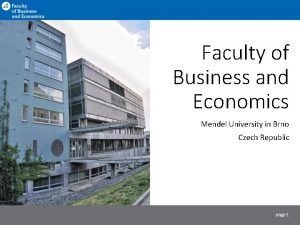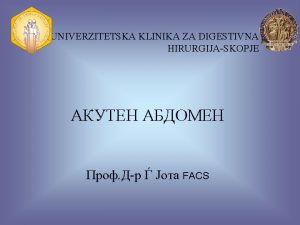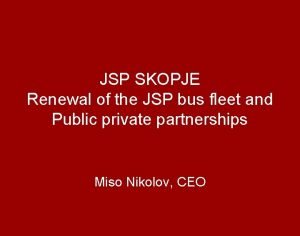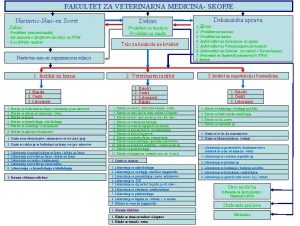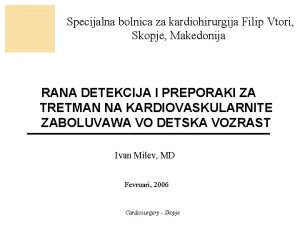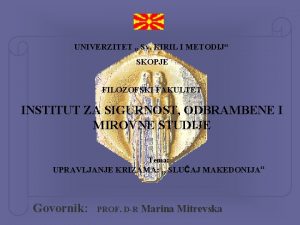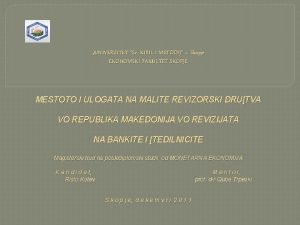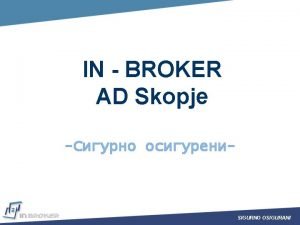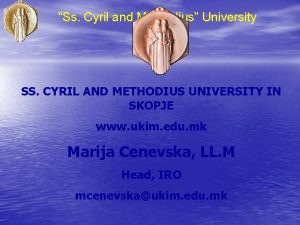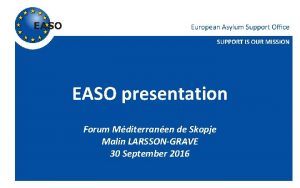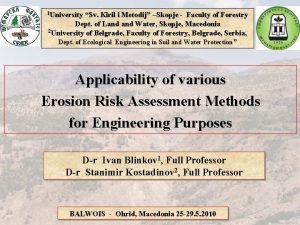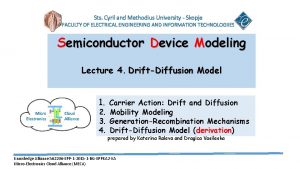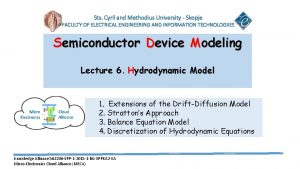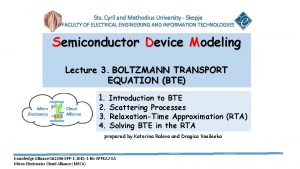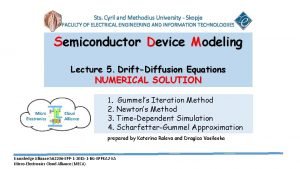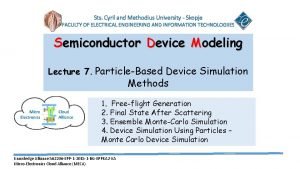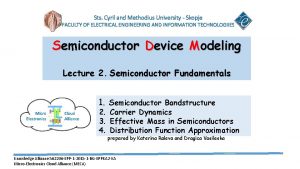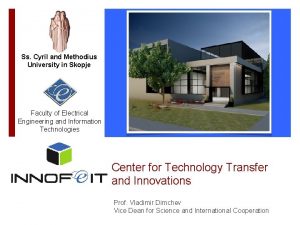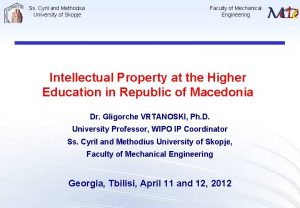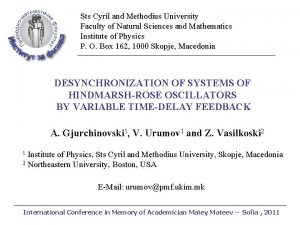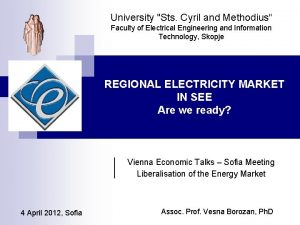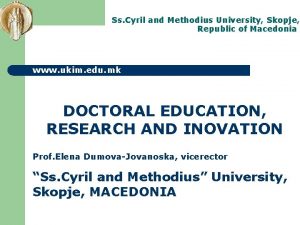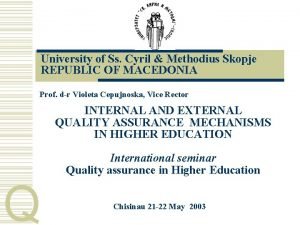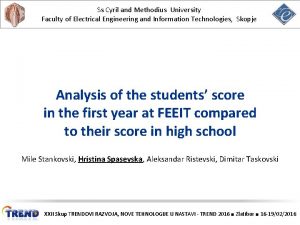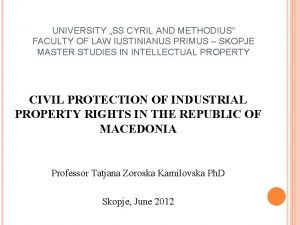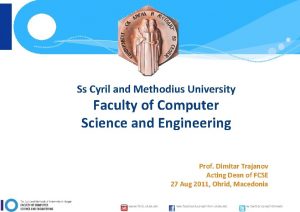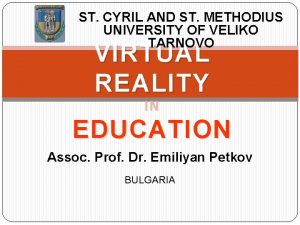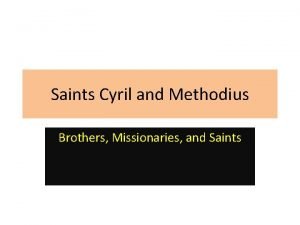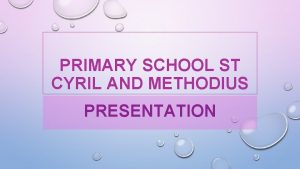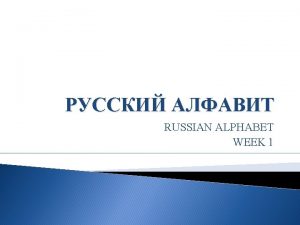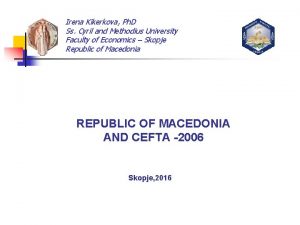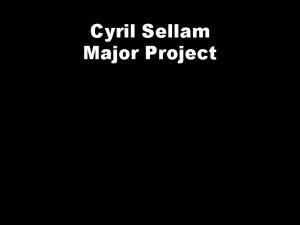Sts Cyril and Methodius University Skopje FACULTY OF


























- Slides: 26

Sts. Cyril and Methodius University - Skopje FACULTY OF ELECTRICAL ENGINEERING AND INFORMATION TECHNOLOGIIES Semiconductor Device Modeling Lecture 1. INTRODUCTION 1. Technology Trends 2. Need for Modeling and Simulation 3. What is Computational Electronics? 4. The Hierarchy of Transport Models prepared by Katerina Raleva and Dragica Vasileska Knowledge Alliance 562206 -EPP-1 -2015 -1 -BG-EPPKA 2 -KA Micro-Electronics Cloud Alliance (MECA)

I. Technology Trends … Transistor Scaling Transistor Scaling

Technology Trends: Scaling Downsizing of the components has been the driving force for circuit evolution: 1900 VT 10 cm 1950 Transistor cm 1960 IC mm 1970 LSI 10 µm 2000 ULSI 100 nm In 100 years, the size reduced by one million times. We have never experienced such a tremendous reduction of devices in human history.

Transistor Scaling - Drive For… “Every 1. 5 -2 years complexity doubles” Dense Memory Speed Low Power High Frequency Scaling Down Complexity Space

Technical Drivers of Semiconductor Industry: DRAM and MCUs DRAM Microprocessor Different performance More memory criteria for these two density major product families More speed

The key parameter in MCUs: Gate Length MOSFET Gate Length (nm) Transistors per processor chip Year

Technology Trends: Traditional Scaling Gate Oxide Thickness Scaling -key enabler for Lg scaling Junction Scaling -another enabler for Lg scaling -improve abruptness (Rext reduction) Vcc Scaling -reduce xdepl (improve SCE) -did not follow constant E field

Technology Trends: Post “Traditional Scaling” Innovations 90 nm 2003 65 nm 2005 45 nm 2007 32 nm 2009 22 nm 2011 Fin. FET Mobility booster: uniaxial strain Gate leakage reduction: Hi. K Poly depletion elimination: metal gate

II. Need for Modeling and Simulation

Modeling Nano-Devices and Parallel Computing… As semiconductor feature sizes shrink into the nanometer scale regime, even conventional device behavior becomes increasingly complicated…. Typical modeling and simulation efforts directed towards the understanding of electron transport at the nanometer scale utilize single workstations as computational engines…. Very long computational time!!! Parallelization of scientific and engineering oriented simulation codes can provide significant computational speed-up.

Need for Modeling and Simulation Increased costs for R&D and production facilities, which are becoming too large for any one company or country to accept. Shorter process technology life cycles. Emphasis on faster characterization of manufacturing processes, assisted by modeling and simulation.

Modeling and Simulation • Modeling and simulations are two closely related computer applications which play a major role in science and engineering today. • They help scientists and engineers to reduce the cost and time consumption for research. • They are also useful for ordinary people to understand be trained for something easily.

What is Modeling ? Modeling is creating a ‘model’ which represents an object or system with its all or subset of properties. A model may be exactly the same as the original system or sometimes approximations make it deviates from the real system. • A mathematical model describes a system with equations. Modeling can reduce the cost of a process and make the progress faster

What is Simulation? • Simulation is a technique of studying and analyzing the behavior of a real world or an imaginary system by mimicking it on a computer application. • A simulation works on a mathematical model that describes the system. • In a simulation, one or more variable of the mathematical model is changed and resulted changes in other variables are observed.

Diferences between Modeling and Simulation 1. Both computer modeling and simulations are computer applications which represent a real world or imaginary system. 2. Both computer modeling and simulations help designers to save time and money. 3. A simulation is changing one or more variables of a model and observing the resulted changes. 4. Although a model always tries to represent the actual system, system a simulation may try to observe the results by doing impossible (in real world) changes. 5. A model can be considered as a static and a simulation can be considered as dynamic as the variables of a simulation get always changed.

III. What is Computational Electronics? UNIVAC ENIAC

What is Computational Electronics ? Customer Need Process Simulation Device Simulation Parameter Extraction Circuit Level Simulation no yes -refers to the physical simulation of semiconductor devices in terms of charge transport and the corresponding electrical behavior.

The Goal of Computational Electronics -to provide simulation tools with the necessary level of sophistication to capture the essential physics while at the same time minimizing the computational burden… Building a Simulator from Scratch… Input Examples Documentation Physics Output Downloads

Basic Elements of Device Simulations There are two main kernels in device simulations that need to be solved self-consistently with one another: Electronic Structure, Lattice Dynamics KERNEL 2 (driving charge flow) Electromagnetic Fields J, r E, B Device Simulation Transport Equations KERNEL 1 (governing charge flow)

IV. The Hierarhy of Transport Models Electronic Structure, Lattice Dynamics Electromagnetic Fields J, r E, B Device Simulation Transport Equations

Hierarhy of Transport Models Approximate Quantum Semi-classical 1. Compact models Exact 2. Drift–Diffusion Equations Easy, fast 3. Hydrodynamics Equations 4. Boltzmann Transport Equation (Monte Carlo methods) 5. Quantum Hydrodynamics 6. Quantum Monte Carlo methods 7. Quantum-Kinetic Equation (Liouville, Wigner-Boltzmann) Covered in this course 8. Green’s Functions method 9. Direct solution of the nbody Schrodinger Equation Difficult, slow

Diffusive vs. Ballistic Transport ‘Classical’ Transport regime depends on length scale: l - Phase coherence length lin - Inelastic mean free path le - Elastic mean free path ‘Quantum’

Nanoscale Transistors

Advantages and Disadvantages of Existing Semi-classical Simulators DRIFT-DIFFUSION MODEL: Good for devices with LG>0. 5 mm. Can’t deal with hot-carrier effects. HYDRODYNAMIC MODEL: Hot-carrier effects, such as velocity overshoot, included. Overestimates the velocity at high fields. PARTICLE-BASED DEVICE SIMULATION: Accurate up to classical limits. Allow proper treatment of the discrete impurity effects and e-e and e-i interactions. Time consuming.

Range of Validity of Various Transport Regimes L<<le-ph L<le-e L>>le-e Transport regime Quantum Ballistic Fluid Scattering Rare Model Drift Diffusion Hydrodynamic Monte Carlo Schrodinger/ Green’s Functions Applications L~le-ph L>>le-ph Fluid Diffusive e-e (Many), e-ph (Few) Many Quantum hydrodynamic Wave Nanowires, Superlattice Ballistic Transistor Current IC’s Older IC’s

Summary • Different transport models exist with different accuracy and different computational needs for modeling the wide variety of devices that are used in practice every day. • The goal of Computational Electronics is to teach one what models are appropriate for modeling specific device structure and what are the limitations and the advantages of the model used.
 Faculty of business and economics mendel university in brno
Faculty of business and economics mendel university in brno Elearningunideb
Elearningunideb Mendel university faculty of business and economics
Mendel university faculty of business and economics Klinika za digestivna hirurgija-skopje
Klinika za digestivna hirurgija-skopje Università san cirillo e metodio skopje
Università san cirillo e metodio skopje Jsp plan
Jsp plan Veterinaren fakultet skopje
Veterinaren fakultet skopje Bolnica filip vtori
Bolnica filip vtori Fakultet za psihologija skopje
Fakultet za psihologija skopje Ekonomski fakultet skopje
Ekonomski fakultet skopje Osiguritelni kompanii
Osiguritelni kompanii Bioshield skopje
Bioshield skopje Pmf skopje
Pmf skopje Dif fakultet skopje
Dif fakultet skopje Bereket skopje
Bereket skopje Sv kiril i metodij skopje
Sv kiril i metodij skopje Herszon kherson maritime college of merchant marine fleet
Herszon kherson maritime college of merchant marine fleet University of bridgeport engineering
University of bridgeport engineering University of bridgeport engineering
University of bridgeport engineering Hubert kairuki memorial university faculty of medicine
Hubert kairuki memorial university faculty of medicine Solid thyroid nodule
Solid thyroid nodule King abdulaziz university faculty of medicine
King abdulaziz university faculty of medicine Florida state university computer science faculty
Florida state university computer science faculty Singularity executive program
Singularity executive program Territorial matrix vs interterritorial matrix
Territorial matrix vs interterritorial matrix Masaryk university medical faculty
Masaryk university medical faculty Faculty of engineering university of porto
Faculty of engineering university of porto


